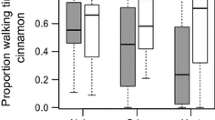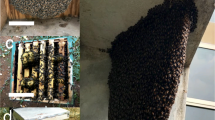Abstract
An important factor inducing variability in foraging behavior in parasitic wasps is experience gained by the insect. Together with the insect's genetic constitution and physiological state, experience ultimately defines the behavioral repertoire under specified environmental circumstances. We present a conceptual variable-response model based on several major observations of a foraging parasitoid's responses to stimuli involved in the hostfinding process. These major observations are that (1) different stimuli evoke different responses or levels of response, (2) strong responses are less variable than weak ones, (3) learning can change response levels, (4) learning increases originally low responses more than originally high responses, and (5) hostderived stimuli serve as rewards in associative learning of other stimuli. The model specifies how the intrinsic variability of a response will depend on the magnitude of the response and predicts when and how learning will modify the insect's behavior. Additional hypotheses related to the model concern how experience with a stimulus modifies behavioral responses to other stimuli, how animals respond in multistimulus situations, which stimuli act to reinforce behavioral responses to other stimuli in the learning process, and finally, how generalist and specialist species differ in their behavioral plasticity. We postulate that insight into behavioral variability in the foraging behavior of natural enemies may be a help, if not a prerequisite, for the efficient application of parasitoids in pest management.
Similar content being viewed by others
References
Alcock, J. (1984).Animal Behavior: An Evolutionary Approach, 3rd ed., Sinauer, Sunderland, Mass.
Arthur, A. P. (1966). Associative learning inItoplectis conquisitor (Say) (Hymenoptera: Ichneumonidae).Can. Entomol 98: 213–223.
Arthur, A. P. (1971). Associative learning byNemeritis canescens (Hymenoptera: Ichneumonidae).Can. Entomol. 103: 1137–1141.
Carew, T. J., Abrams, T. W., Hawkins, R. D., and Kandel, E. R. (1984). The use of simple invertebrate systems to explore psychological issues related to associative learning. In Alkon, D. L., and Parley, J. (eds.),Primary Neural Substrates of Learning and Behavioural Change, Cambridge University Press, Cambridge, pp. 169–184.
Corbet, S. A. (1985). Insect chemosensory responses: A chemical legacy hypothesis.Ecol. Entomol. 10: 143–153.
Cornell, H. (1976). Search strategies and the adaptive significance of switching in some general predators.Am. Nat. 110: 317–320.
Daly, M., Rauschenberger, J., and Behrends, P. (1980). Food-aversion learning in kangaroo rats: a specialist-generalist comparison.Anim. Learn. Behav. 10: 314–320.
Dicke, M., Sabelis, M. W., and Groeneveld, A. (1986). Vitamin A deficiency modifies response of predatory miteAmblyseius potentillae to volatile kairomone of two-spotted spider mite.J. Chem. Ecol. 12: 1389–1396.
Drost, Y. C., Lewis, W. J., Zanen, P. O., and Keller, M. A. (1986). Beneficial arthropod behavior mediated by airborne semiochemicals. I. Flight behavior and influence of preflight handling ofMicroplitis croceipes (Cresson).J. Chem. Ecol. 12: 1247–1262.
Drost, Y. C., Lewis, W. J., and Tumlinson, J. H. (1988). Beneficial arthropod behavior mediated by airborne semiochemicals. V. Influence of rearing method, host plant and adult experience on host-searching behavior ofMicroplitis croceipes (Cresson), a larval parasitoid ofHeliothis.J. Chem. Ecol. 14: 1607–1616.
Gould, J. L., and Marler, P. (1984). Ethology and the natural history of learning. In Marler, P., and Terrace, H. S. (eds.),The Biology of Learning, pp. 47–74. Springer-Verlag, New York.
Gross, H. R., Lewis, W. J., Jones, R. L., and Nordlund, D. A. (1975). Kairomones and their use for the management of entomophagous insects. III. Stimulation ofTrichogramma achaeae, T. pretiosum andMicroplitis croceipes with host seeking stimuli at the time of release to improve their efficiency.J. Chem. Ecol. 1: 431–438.
Hérard, F., Keller, M. A., Lewis, W. J., and Tumlinson, J. H. (1988). Beneficial arthropod behavior mediated by airborne semiochemicals. IV. Influence of host diet on host-oriented flight chamber responses ofMicroplitis demalitor Wilkinson.J. Chem. Ecol. 14: 1597–1606.
Herrebout, W. M. (1969). Habitat selection inEucarcelia rutilla Vill. (Diptera: Tachinidae). II. Experiments with females of known age.Z. ang. Ent. 63: 336–349.
Herrebout, W. M. and van der Veer, J. (1969). Habitat selection inEucarcelia rutilla Vill. (Diptera: Tachinidae). III. Preliminary results of olfactometer experiments with females of known age.Z. ang. Ent. 64: 55–61.
Jaenike, J. (1982). Environmental modification of oviposition behavior inDrosophila. Am. Nat.119: 784–802.
Jaenike, J. (1983). Induction of host preference inDrosophila melanogaster. Oecologia58: 320–325.
Jaenike, J. (1988). Effects of early adult experience on host selection in insects: Some experimental and theoretical results.J. Insect Behav. 1: 3–15.
Keller, M. A., Lewis, W. J., and Stinner, R. E. (1985). Biological and practical significance of movement byTrichogramma species: A review.Southwest. Entomol. Suppl. 8: 138–155.
Lewis, W. J., and Tumlinson, J. H. (1988). Host detection by chemically mediated associative learning in a parasitic wasp.Nature 331: 257–259.
Lewis, W. J., Jones, R. L., Gross, H. R., and Nordlund, D. A. (1976). The role of kairomones and other behavioral chemicals in host finding by parasitic insects.Behav. Biol. 16: 267–289.
Lewis, W. J., Vet, L. E. M., Tumlinson, J. H., van Lenteren, J. C., and Papaj, D. R. (1990). Variations in parasitoid foraging behavior: Essential element of a sound biological control theory.Environ. Entomol. (in press).
Manning, A. (1972).An Introduction to Animal Behaviour, Edward Arnold, London.
Menzel, R. (1983). Neurobiology of learning and memory: The honeybee as a model system.Naturwissenschaften 70: 504–511.
Mollema, C. (1988). Heritability of host selection behaviour ofAsobara tabida. InGenetical Aspects of Resistance in a Host-Parasitoid Interaction, Ph.D. thesis, University of Leiden, Leiden, The Netherlands, pp. 99–107.
Monteith, L. G. (1963). Habituation and associative learning inDrino bohemica Mesn. (Diptera: Tachinidae).Can. Entomol. 95: 418–426.
Nishida, T. (1956). An experimental study of the ovipositional behavior of Opius fletcheri Silvestri (Hymenoptera: Braconidae), a parasite of the melon fly.Proc. Haw. Entomol. Soc. 16: 126–134.
Noldus, L. P. J. J. (1988). Response of the egg parasitoidTrichogramma pretiosum to the sex pheromone of its hostHeliothis zea. Entomol. Exp. Appl.48: 293–300.
Noldus, L. P. J. J., Lewis, W. J., Tumlinson, J. H., and van Lenteren, J. C. (1988). Olfactometer and windtunnel experiments on the role of sex pheromones of noctuid moths in the foraging behaviour ofTrichogramma spp. In Voegel, J., Waage, J. K., and van Lenteren, J. C. (eds.),Trichogramma and Other Egg Parasites, Colloq. INRA 43, INRA, Paris, pp. 223–238.
Papaj, D. R., and Prokopy, R. J. (1986). Phytochemical basis of learning inRhagoletis pomonella and other herbivorous insects.J. Chem. Ecol. 12: 1125–1143.
Papaj, D. R., and Prokopy, R. J. (1989). Ecological and evolutionary aspects of learning in phytophagous insects.Annu. Rev. Entomol. 34: 315–350.
Papaj, D. R., and Rausher, M. D. (1983). Individual variation in host location by phytophagous insects. In Ahmad, S. (ed.),Hebivorous Insects: Host-Seeking Behavior and Mechanisms, Academic Press, New York.
Papaj, D. R., and Vet, L. E. M. (1990). Odor learning and foraging success in the parasitoid,Leptopilina heterotoma. J. Chem. Ecol.16(11) (in press).
Papaj, D. R., Opp, S. B., Prokopy, R. J., and Wong, T. T. Y. (1989). Cross-induction of host fruit acceptance in medfly: The role of fruit size and chemistry.J. Insect Behav. 2: 241–254.
Prévost, G., and Lewis, W. J. (1990). Genetic differences in the response ofMicroplitis croceipes to volatile semiochemicals.J. Insect Behav. 3: 277–287.
Prokopy, R. J., Averill, A. L., Cooky, S. S., and Roitberg, C. A. (1982). Associative learning in egglaying site selection by apple maggot flies.Science 218: 76–77.
Ridgway, R. L., Ables, J. R., Goodpasture, C., and Hartstack, A. W. (1981).Trichogramma and its utilization for crop protection in the U.S.A. InProceedings Joint American-Soviet Conference, “Use of Beneficial Organisms in the Control of Crop Pests,” Washington, D.C., pp. 41–48.
Sahley, C. L. (1984). Behavior theory and invertebrate learning. In Marier, P., and Terrace, H. S. (eds.),The Biology of Learning, Springer-Verlag, New York, pp. 181–196.
Sheehan, W., and Shelton, A. M. (1989). The role of experience in plant foraging by the aphid parasitoidDiaretiella rapae (Hymenoptera: Aphidiidae).J. Insect Behav. 2: 743–759.
Smith, M. A., and Cornell, H. V. (1978). Hopkins host-selection inNasonia vitripennis and its implications for sympatric speciation.Anim. Behav. 27: 365–370.
Sokal, R. R., and Rohlf, F. J. (1981).Biometry, Freeman, New York.
Thorpe, W. H., and Jones, F. G. W. (1937). Olfactory conditioning in a parasitic insect and its relation to the problem of host selection.Proc. R. Soc. Ser. B 124: 56–81.
Tinbergen, N. (1951).The Study of Instinct, Oxford University Press, London.
Turlings, T. C. J., Tumlinson, J. H., Lewis, W. J., and Vet, L. E. M. (1989). Beneficial arthropod behavior mediated by airborne semiochemicals. III. Learning of host-related odors induced by a brief contact experience with host by-products inCotesia marginiventris (Cresson), a generalist larval parasitoid.J. Insect Behav. 2: 217–225.
van Alphen, J. J. M., and Vet, L. E. M. (1986). An evolutionary approach to host finding and selection. In Waage, J. K., and Greathead, D. J. (eds.),Insect Parasitoids, Academic Press, London, pp. 23–61.
Vet, L. E. M. (1983). Host-habitat location through olfactory cues byLeptopilina clavipes (Hartig) (Hym.: Eucoilidae), a parasitoid of fungivorousDrosophila: The influence of conditioning.Neth. J. Zool. 33: 225–248.
Vet, L. E. M. (1985). Olfactory microhabitat location in some eucoilid and alysiine species (Hymenoptera), larval parasitoids of Diptera.Neth. J. Zool. 35: 720–730.
Vet, L. E. M. (1988). The influence of learning on habitat location and acceptance by parasitoids. InParasitoid Insects (Lyon, September 7–10, 1987), Les Colloques de l'INRA 48, INRA, Paris, pp. 29–34.
Vet, L. E. M., and van Alphen, J. J. M. (1985). A comparative functional approach to the host detection behaviour of parasitic wasps. I. A qualitative study on Eucoilidae and Alysiinae.Oikos 44: 478–486.
Vet, L. E. M., and Groenewold, A. W. (1990). Semiochemicals and learning in parasitoids.J. Chem. Ecol. 16(11) (in press).
Vet, L. E. M., and Janse, C. J. (1984). Fitness of two sibling species ofAsobara (Braconidae: Alysiinae), larval parasitoids of Drosophilidae in different microhabitats.Ecol. Entomol. 9: 345–354.
Vet, L. E. M., and Schoonman, G. (1988). The influence of previous foraging experience on microhabitat acceptance inLeptopilina heterotoma. J. Insect Behav.1: 387–392.
Vet, L. E. M., and van Opzeeland, K. (1984). The influence of conditioning on olfactory microhabitat and host location inAsobara tabida (Nées) andA. rufescens (Foerster) (Braconidae: Alysiinae), larval parasitoids of Drosophilidae.Oecologia 63: 171–177.
Vet, L. E. M., van Lenteren, J. C., Heymans, M., and Meelis, E. (1983). An airflow olfactometer for measuring olfactory responses of hymenopterous parasitoids and other small insects.Physiol. Entomol. 8: 97–106.
Vet, L. E. M., Janse, C., van Achterberg, C., and van Alphen, J. J. M. (1984). Microhabitat location and niche segregation in two sibling species of Drosophilid parasitoids:Asobara tabida (Nees) andA. rufescens (Foerster) (Braconidae: Alysiinae).Oecologia 61: 182–188.
Vinson, S. B. (1976). Host selection by insect parasitoids.Annu. Rev. Entomol. 21: 109–134.
Vinson, S. B. (1981). Habitat location. In Nordlund, D. A., Jones, R. L., and Lewis, W. J. (eds.),Semiochemicals: Their Role in Pest Control, Wiley, New York, pp. 51–77.
Vinson, S. B. (1984). How parasitoids locate their hosts: A case of insect espionage. In Lewis, T. (ed.),Insect Communication, R. Entomol. Soc., London, pp. 325–348.
Vinson, S. B., Barfield, C. S., and Henson, R. D. (1977). Oviposition behaviour of Bracon mellitor, a parasitoid of the boll weevil (Anthonomus grandis). II. Associate learning.Physiol. Entomol. 2: 157–164.
Visser, J. H. (1988). Host-plant finding by insects: Orientation, sensory input and search patterns.J. Insect Physiol. 34: 259–268.
Waage, J. K. (1979). Foraging for patchily-distributed hosts by the parasitoid,Nemeritis canescens.J. Anim. Ecol 48: 353–371.
Wardle, A. R., and Borden, J. H. (1986). Detrimental effect of prior conditioning on host habitat location byExeristes roborator.Naturwissenschaften 73: 559–560.
Author information
Authors and Affiliations
Rights and permissions
About this article
Cite this article
Vet, L.E.M., Lewis, W.J., Papaj, D.R. et al. A variable-response model for parasitoid foraging behavior. J Insect Behav 3, 471–490 (1990). https://doi.org/10.1007/BF01052012
Accepted:
Issue Date:
DOI: https://doi.org/10.1007/BF01052012




